This 75-minute video lecture course complements the release of the Orchestral Study Score of Alex North's Main Title cue "Bones", originally written for the movie 2001: A Space Odyssey.
As well as the video lectures, the course includes 3 different condensed PDF scores of the Bones/Main Title cue with onscreen score excerpts matched to audio from the original 1968 film scoring session. This way what you see, you hear. Color-coded score excerpts matched to audio make it easy for nearly anyone to follow along with the videos - even if your music reading skills aren't great. Also included is our special video-version Spectrotone Chart (does not include the PDF training guides which you can find in the full version of the Spectrotone Instrumental Tone-Color Chart).
Watch an excerpt from the Course
*If you can’t see the YouTube video above, please accept cookies to view and play the video.
Teaching Focus: Orchestration and Composition
Taught by Peter Lawrence Alexander (author of the Professional Orchestration.
™, Visual Orchestration
™, Scoring Stages
™ series and more) the
Bones/Main Title video lectures focus on span of orchestration, composition and orchestration techniques - most of which can be done with orchestral samples. The videos, running about 75 minutes, are divided into five chapters. These are:
Chapter 1 – Introduction
Chapter 2 – Composer and Orchestrator: A Collaborative Relationship
Chapter 3 – Instrumentation Selected for Bones
Chapter 4 – Orchestral and Instrumental Range
Chapter 5 – Full Score Analysis
Detailed Chapter Breakdown
Below is a detailed chapter by chapter review.
Chapter 1 – Introduction. Reviews the use of Platform Purple, and the contents of the learning materials including 3 different condensed sketch scores: standard, by register, and 4-staves with timpani. Also included is a special onscreen version of the Spectrotone Chart.
Chapter 2 – Composer and Orchestrator: A Collaborative Relationship. Orchestrating and orchestrator defined. What's provided to the orchestrator. The four approaches in working with an orchestrator. Alex North and his two approaches in working with orchestrators. Comparison between Bones and The Bluff cues from 2001. The 3 types of collaboration with an orchestrator. How Alex North and Henry Brant complemented each other.
Chapter 3 – Instrumentation Selected For Bones. Alex North's goals in film scoring. How instrumentation is considered and planned. Review of instrumentation for this cue: Woodwinds in 4s, Expanded Brass, Double Harps, Organs, and String Section Size. Woodwind size comparison with MIDI mock-up insights. North's brass compared to a standard brass section. Focus on the Euphonium, and the organs used in the cue. The conical instruments. MIDI mock-up considerations.
Chapter 4 – Orchestral and Instrumental Range. Two Types of Ranges and each defined. Range breaks for both orchestral and instrumental range. Application seen with the Spectrotone Chart. The five orchestral registers. Darker to Brighter tone colors. Coffee Break!
Chapter 5 – Full Score Analysis. Also includes audio from the original 1968 mono recording to illustrate score sections. In 3 parts:
Part 1 - the three condensed scores; condensed score terms; Focus is registration and instrumentation; bars 1-11; tone colors entering and closing; tone colors sustaining; pedal point and doubles; combinations and the Spectrotone Chart; the Cone Horns; the Cone Horns Ensemble; Placement by registers and Dynamic Equivalents with the brass; the Blue Box; Hi Strings as Single Unit; Bruckner and Alex North; Debussy and Hi Strings as unit; Hi Strings Doubled with Hi Woodwinds; Bones and Dynamic Equivalents; The Unit.
Part 2 – The Unit + 3 more trumpets; back to Dynamic Equivalents and balance; Trumpets 4-6; the Purple Circle; Orchestration is Composition; summary of entrances by number; Enclosure; Orchestral Change; An Alex North Principal; Underlying form of Bones; Where Alex North divided the orchestra; Bars 19 to the end; the Four Stave View.
Part 3 – Backtracking to Bar 15; More Dynamic Equivalents; the Big Sound; Bars 19 – 20; Henry Brant on Recording Alex North; Bones by Vertical Register; the full score blocked out; the whole cue with audio conducted by Henry Brant; Summary.
The Condensed PDF Scores
Produced using PreSonus' Notion 5 software, the three condensed custom PDF scores are a breakthrough for learning film composition and orchestration. The first PDF score is 10 staves and reflects the standard orchestral layout. The second condensed score follows the Spectrotone Chart and is organized by register. The third and final condensed score has Bones reduced to four staves plus a fifth line for timpani.
The PDF scores can be used two ways. You can view them in the onscreen Purple Player which can be read on your computer monitor, or other supported devices, separate from the video lecture. Or, you can download and print them out, sized in 8.5" x 11" format (watermarked with your unique user ID) that you can resize to fit whatever printer you have. You can print as many copies of the condensed PDF scores as you like for your own private study use.
In fact, you may find the condensed PDF scores the star of the course because of how they make learning composition and orchestration so much easier. By matching the condensed scores with the separately available Orchestral Study Score of Alex North's Main Title cue "Bones", you'll learn a lot about score reductions and why producing them is such a useful study tool to help you really see the compositional structure behind a full orchestral work. Of course, you'll need to read music to make the most use of them.
Bones Audio from the Original Recording Session
Score study in the video lectures has been brought to life by matching score examples from Bones to the original score recording session, courtesy of the North family. Score excerpts are also color-coded to make studying with the video even easier. The audio comes from the original 1968 mono recording of the Bones/Main Title cue which was orchestrated and conducted by Pulitzer Prize winning composer/orchestrator Henry Brant, author of Textures and Timbres: An Orchestrator's Handbook.
As this is the original 1968 mono recording, don't expect audiophile quality! If you want a newer stereo version to compare with the 1968 original, you can separately purchase a recording of "Alex North's 2001" score by Jerry Goldsmith and the National Philharmonic Orchestra. Published by Varèse Sarabande, it was released in 1993 but is still available at iTunes, Amazon, and similar music retailers.
Learn Wherever You Are
You'd spend hundreds of dollars learning these scoring techniques in either expensive seminars (live or online) or expensive college classes. But with the Alex North Film Scoring Video Lecture Series you can learn in the comfort of your own home, on vacation, or traveling the Tube.
If you've ever wanted to study real film cues and learn what's really going on, now you can...
Product Delivery Information:
- Approx. 1 hour 15 minutes of videos plus PDF condensed scores / Approx. 607 MB required for product, with additional space for optional Purple Player app, depending on your device.
- Upon purchase, your digitally delivered order will be fulfilled by Platform Purple. The videos and PDFs can be streamed through your free Platform Purple Library account, or you can optionally download and install the free Platform Purple app (Mac or PC) and download the course through the app for offline viewing. Free IOS and Android apps are also available.
- Please click on the Platform Purple tab above for more information.
About Alex North
Alex North received 15 Oscar nominations and a Lifetime Achievement Oscar for his work in the film industry at the 1986 Oscars. He was the first composer to receive this honor for his music.
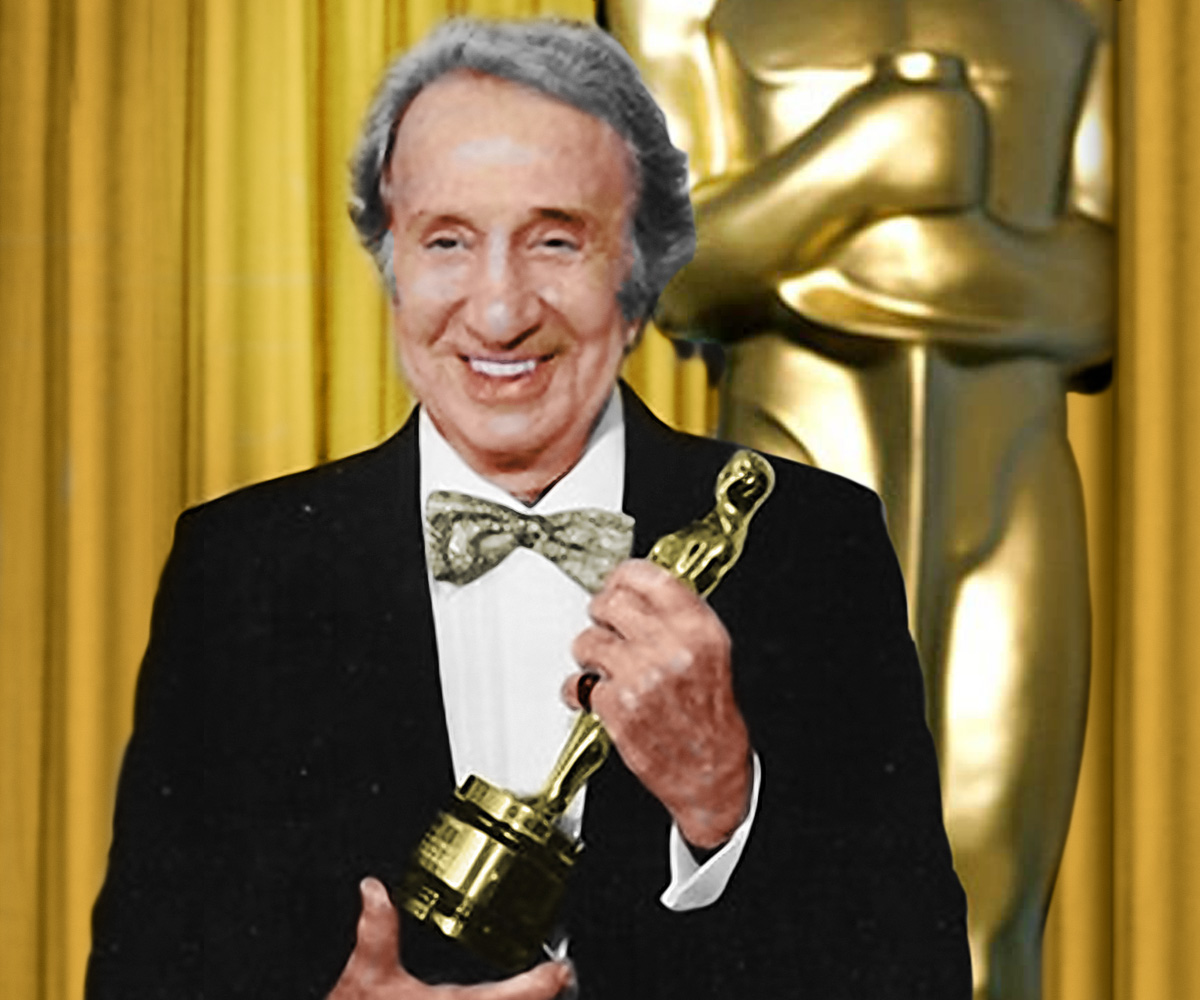
Growing up in Chester, Pennsylvania, times were tough. To make ends meet after his blacksmith father died, Alex's mother took in boarders and saved enough money to send two of his brothers to college. Despite the lean times, the North household was filled with music, and Alex's extraordinary musical talent earned him scholarships to Philadelphia's Curtis Institute, where he studied piano with George Boyle, and New York's Juilliard School, where he took courses in composition with Bernard Wagenaar from 1929 to 1932.
While at Juilliard he worked nights as a telegrapher, which ruined his health. But his fascination with new Russian music, especially that of Prokofiev, made him interested in going to Russia. The Soviets needed telegraphers. And so North applied, was accepted, and went to Russia where he studied composition on scholarship at the Moscow Conservatory—its first American pupil—with Anton Weprik and Victor Biely, from 1932 to 1935.
While he was in Russia, North served as music director of the Latvian State Theater. Later in life, Alex would teach at Bennington, Briarcliffe and Finch colleges in the US.
But North became homesick in Moscow. And so he returned to New York in 1936, where he continued his studies with Aaron Copland (1936-39), and Ernst Toch (1938-39)—who would soon move to Hollywood to score films.
North wrote scores in New York for the Federal Theater project, worked as Martha Graham's rehearsal pianist—he wrote the 1937 dance American Lyric for her company—and did ballets for Hanya Holm, and most importantly, for Anna Sokolow, who left Graham to form her own company. North became her music director and accompanied Sokolow and her troupe on a tour of Mexico in 1939. While there he also studied with the highly original Mexican composer Silvestre Revueltas, who wrote a number of striking film scores.
One of North's first film scores—he started in 1936—was for Elia Kazan's documentary short People of the Cumberland (1937).
The US Army drafted Alex in 1942 and, noticing his flair for film scoring, he ended up scoring over 25 Office of War Information documentaries like A Million Children (1944), and Library of Congress (1945).
North also developed musical psychodramas with the innovative psychiatrist Karl Menninger at this time.
After the war he returned to New York where he wrote music for the theater and concert pieces like Revue for Clarinet and Orchestra (1946), which Benny Goodman and Leonard Bernstein premiered with the City Symphony of New York, and Rhapsody for Piano and Orchestra (1941). He received a Guggenheim Fellowship in 1947 to write his first symphony, and wrote another one, in 1968, called Africa—Symphony To A New Continent.
But it was his music for theater productions of Death of a Salesman (1949) and The Innocents (1950) that earned him an invitation to Hollywood to score Kazan's film version of his Broadway production of Tennessee Williams' A Streetcar Named Desire (1951). That groundbreaking film marked the first time that a jazz score was fully integrated into the onscreen drama, and North's success with this music has been credited with opening up film scoring to a new generation of composers. Prior to North's score, jazz had functioned only as background music. The pscho-sexual tensions in North's music here were so intense that the Legion of Decency called it "carnal", and asked that the composer remove his "offending" sax solo in one place!
This was not to be the first surprise North encountered in Hollywood. North's original score for 2001: A Space Odyssey was removed right before the release of the film and replaced with music by Strauss and Ligeti. This tragic loss was rectified by the recording and release of the 2001 CD by Varese Sarabande Records. The orchestra for this recording was conducted by his friend and colleague, Jerry Goldsmith.
It’s North's emotional integrity that led critic Brooks Atkinson, of the New York Times, to say about one of his theater scores: "Alex North has composed a witch's chorus that is pithy, practical, and terrifying. Give Mr. North a theme, and he goes straight to the heart of it without any musical pretensions." This became one of North's favorite assessments of his work and it concisely explains why North had such a long and successful career.
North wrote more than 50 film scores, but despite 15 nominations for Oscars, he didn't return home with a statue until he won the Lifetime Achievement Oscar in 1986. In a series of interviews after that welcome recognition, North told Steven Smith of the Los Angeles Times that "fear is a problem with film music and films; people want to be conventional, and there's more commercialism today. If you are not daring in your art, you're bankrupt."
The diverse body of North's accomplishments is full of heavy dramas and social themes, like Death of a Salesman, Who's Afraid of Virginia Wolf, Rich Man Poor Man and Spartacus, as well as the more light-hearted Prizzi's Honor. One might think that North naturally gravitated to the Hollywood epic, but his widow Anne North, disagrees. "The big epics weren't really his big love. What he always wanted was to write music for films where he was able to relate to the characters."
Even by his own stringent standards, Alex North was a man who had daring and integrity, and his music shows it. As you study the film cues of Alex North you'll be awed by the depth and breadth of his work, particularly as you learn to apply his insights to your own music.
From alexnorthmusic.com, used by permission.
About Peter Lawrence Alexander
Peter Lawrence Alexander was the first American to create in English the multi-volume Professional Orchestration.™ Series which has been endorsed by winners of the Academy, Grammy, Emmy, and BAFTA Awards. He’s also the author and teacher of Visual Orchestration™, Scoring Stages™, How Ravel Orchestrated: Mother Goose Suite, The Instant Composer™: Counterpoint by Fux, Writing For Strings, Applied Professional Harmony™ 101 and 102, How MIDI Works, Street Smart Guide™ to the Vienna Instruments Player and many more. Peter was also Film Music Magazine’s award winning Music Technology Journalist.
A graduate of Berklee College of Music in Boston with a BS In Music Composition, he studied counterpoint privately with Dr. Hugo Norden of Boston University, and orchestration with Pulitzer Prize nominated composer Albert Harris. Peter worked as the music tech for film composer/songwriter Henry Mancini and understudied with film composer Jerry Goldsmith. He also studied orchestration with Goldsmith's orchestrator, Arthur Morton.
Peter coordinated beta test teams for the Vienna Symphonic Library and co-produced the Modern Symphonic Orchestra orchestral sample library for Creative Labs. As a media researcher he produced studies showing geodemographical radio station listening patterns by day segments, and in working with renowned radio programmer Jack McCoy’s RAM Research he laid the research foundation for what later became Arbitron Information on Demand.
With over 30 years in music education and publishing, Peter’s training approach came out of his research into how the great composers taught themselves. His music books and courses are research-oriented and focus on how people learn best. The result of this approach is titles that train for results, and get results when you follow their step-by-step learning approach. As Peter would say, "it’s not about music theory, it’s about practical learning and doing."
Maintaining Peter's Teaching Legacy: Since the sudden and unexpected passing of Peter Lawrence Alexander in 2015, his music books and courses, along with this website, are now maintained and updated by his wife and long-time business helpmate, Caroline Alexander, who holds a Master of Arts Degree in Music Design for Film and Television.
Purchasing From The Platform Purple Shop
After clicking the Order Now button on this page, you’re immediately taken to the same product page at the Platform Purple Shop. Click the Add To Cart button then Proceed to Checkout. Enter your email address to either create a Platform Purple account or log into an existing account, then click "Continue" and follow the onscreen instructions to complete your purchase. A receipt for your purchase will be sent to your email address.
Please note that your bank or PayPal statement will show Purple Shop for the transaction, not Alexander Creative Media. Platform Purple are a trusted reseller for Alexander Creative Media products and the Merchant of Record for your order.
How To Access Your Platform Purple Products
After purchasing, sign in to your Platform Purple Library at the link below using the email address and password you created for your Platform Purple account:
Access Your Platform Purple Library
Scroll down the page and you will see your Platform Purple purchased products available to stream right away from the cloud. You can also view and download any PDFs in your order from your online Platform Purple Library.
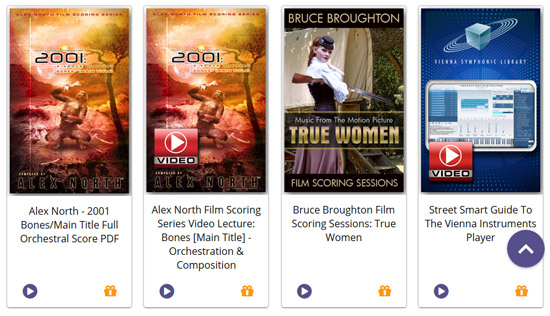
(products shown are for illustrative purposes only.)
Click on the product you want to view:
Alex North - Bones [Main Title] Orchestration and Composition Course: the first video will start playing automatically (it may take a few seconds to load). Under the video, you’ll see playback controls and a Chapter menu to access different videos. Above the video you’ll see an Additional Media button. Click on that button to see a list of the PDFs. Click on a PDF link and the document will open using your web browser’s PDF viewer. Your PDF viewer should let you download the PDFs to your hard drive for offline viewing and printing.
The free Adobe Acrobat Reader is the recommended PDF viewer. You can change your web browser settings to open PDF files using Acrobat Reader if you can’t download the score with your browser’s default PDF viewer (refer to your browser documentation for instructions).
In the purple bar at the top of your screen you’ll see links to return to My Library to view other Platform Purple products you may own, also links to your Platform Purple Account and Support if you need it.

Viewing Platform Purple Products Using the App
At the link below, sign in to your Platform Purple Library using the email address and password you created for your Platform Purple account when you placed your order:
Access Your Platform Purple Library
Look for where it says Select your device for viewing info. Click on the device you want to view your product on and follow the instructions to download and install the app.

Using the Purple Player App for Online or Offline Viewing
We’ll go through the steps for both online and offline viewing using the Windows app. You may find these steps vary slightly if using a different app.
1. When you click Get the app! for Windows a box opens up for you to save the file to your computer.
2. Extract the Purple Player zip file and install the Purple Player setup file. Your file name may look different from what’s shown below.

3. A screen will appear asking you to sign in to your Purple account. Enter the email address and password you used when placing your order.
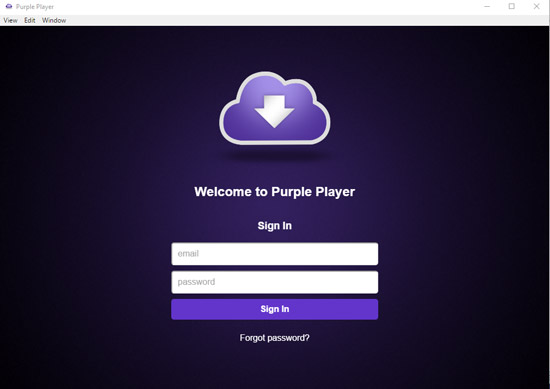
4. Once logged in you will see the products you’ve purchased.
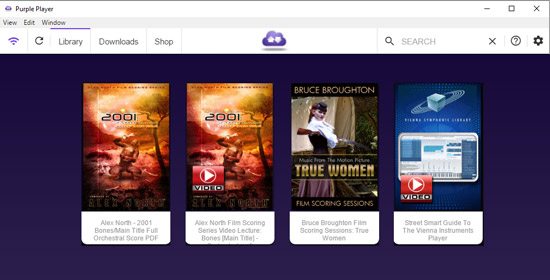
(products shown are for illustrative purposes only.)
5. If you click on a product image from this screen the product will stream from the cloud (provided you’re connected to the internet!) To download the files for offline viewing through the Purple Player app, hover over the product image and look for the Settings cogwheel. Click on the Settings cogwheel, then click Download and the file(s) will download to your hard drive. A download bar will show the progress.
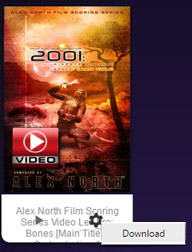
(product shown is for illustrative purposes only.)
Important note: Video files are encrypted in a hidden folder and can *only* be accessed using the Purple Player app. Any PDF files in your order will download to your Documents folder in a sub-folder named Purple Player. If you need to change the default download location of your files you can do so by clicking the main Settings cogwheel at the top right of the screen. Just be aware that you will only be able to open PDF files outside the Purple Player app, not video files. Video files can only by opened and played through the Purple Player app.
6. When the file(s) have finished downloading you will see a green DOWNLOADED badge on the product.
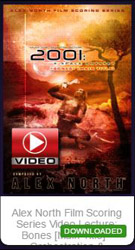
(product shown is for illustrative purposes only.)
If you ever need to re-download a file(s) in the future or remove them from your device, click on the settings cogwheel and you’ll see options for both.
7. To access your downloaded file(s):
Alex North - Bones [Main Title] Orchestration and Composition Course: Click on the product image and the first video will open and start to play. Click on the Chapters button at the bottom of the screen to access different videos. Click on the Additional Media button to access the PDFs, then click the Open in Documents Folder button to open the PDFs from your hard drive. If you click on one of the PDF links, the PDF will be streamed from the cloud.

8. Click the Back to Library button to return to the Purple Player’s home screen.
Support
If you experience any problems you can contact Platform Purple support by clicking the (?) icon in the Purple Player app, or by logging in to your Platform Purple account and clicking the Support link.